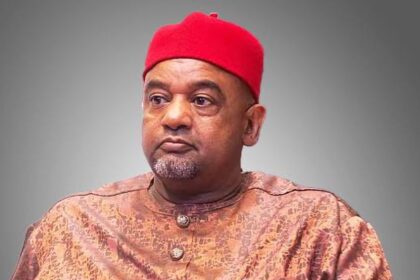*Chromatic Choices Of The Man In Charge
All colours agree with President Bola Ahmed Tinubu. But the colour blue seems simpatico with his aura. It imbues his essence with a patina of grace and elate humanity. Whether turquoise or royal blue, sky blue or cyan, navy or aquamarine, Mr President comes packing with class and unabashed elegance.
While his sartorial choices may seem regimented and restrained to the traditional buba, sokoto and agbada, his preference for blue coloured attires is so resonant it may be likened to bugles of a royal pealing; it summons all and sundry to extol his sartorial depth.
This has brokered fascination with his colour choices so much so that Nigerians within and outside the political circuit have christened him ‘Baba Blue.’ Some take the banter a bit further coining a joke out of it: “the Balablu in Baba Blue” in reference to a parody of his speech en route to the general elections; President Tinubu was serially quoted out of context and his statement got reworded to intone “Balablu” in mischief by his political opposition.
Throughout the history of the Nigerian politics, a president’s clothing choices have been influenced by a number of factors: personal background, economics, regional influences, suggestions from the first lady, and advice from other family members and staff have all contributed to the sartorial style of the nation’s leader.
But why is blue the preferred colour of President Tinubu? Asides from being associated with masculinity, blue is cool and calming as a primary color; it has oftentimes been identified with intelligence, openness, spirituality and creativity.
And going by both traditional and modern colour psychology, President Tinubu’s love of blue marks him as a politician calculatingly obsessed by
the finest detail of political messaging, and more than that, a man prepared to sacrifice himself utterly to the rigor of that discipline, to surrender even something as small, simple and silly as the choice of a garment in the morning to the necessities of political craft.
And that in turn, bolsters confidence in almost everything else he does. Blue portrays him as a man to be trusted. A man for whom every moment and every gesture is heartfelt; a leader for whom even the smallest detail of dressing and sartorial etiquette is designed as a subconscious supplement to the daily message. That degree of calculation is all pervasive and characteristically Bola Tinubu in name and deed.
From one event to the other, President Tinubu has synthesised his personal aura with his political presence and so doing splattered his breadth colourfully in the national imagination. What was once discretionary and variable has become a permanent feature of Mr President’s political imagery thus signalling his ideological divide.
This unintended color-coding of his politics subsists against the backdrop of the political associations of blue that exist almost everywhere else in the world. In various nations, red faces off against blue, replaying social and political divides that first assumed their ideological outlines and their primary colours previous political revolutions or movements.
For instance, the ‘Le Bonnet Rouge’ (‘The Red Hat’) was the name of an anti-government French magazine in the early 20th century in the heat of the French revolution. The bonnet rouge – the soft red cap worn by the French revolutionaries – symbolized their fervour and their solidarity. It was also a defiant appropriation of the red color worn by the government’s supporters.
But it would come to be solely the color of the French left, and after the revolution at the end of the 18th century, red remained their color. When the radicals briefly controlled Paris in 1848 and again in 1871, they raised their red flag over the Hôtel de Ville.
The assertive blue garment would, however, become the colour of brilliance and ingenuity as personified by Tinubu. Blue is serene and reassuring. According to traditional psychology, the colour blue is indicates a deliberate and at times introspective nature. Blue is thoughtful, caring and steadfast. It is connected with expertise and trustworthiness. It also happens to be the color that tends to chosen as favorite of the majority of people around the world. While blue is often associated with conservative movements, values and corporations, it is also connected with duty, patience and perseverance.
Blue is associated with wisdom and a solid character, which some might connect with Mr President’s democratic ideals. His choice of blue indicates his willingness to work hard for all people regardless of socioeconomic class. On the downside, blue has been associated with being overly sensitive and willful, which is how some political opponents might perceive and label Tinubu. People who gravitate toward blue tend to be easy going and charming, and charisma has certainly been a draw of Mr President over the years.
High policy and diplomacy as its part have a common history with sign systems. Colours are anchored in historical and political context associated with the traditional colour symbolism of the conservative world.
Psychologists prove that colours do evoke certain emotional responses in people. So it is nothing new for politicians to be paying attention to what colours they choose for a public appearance.
But while the point of concentration of attention for the American President are his suit and necktie, for many a Nigerian leader, major attention is devoted to traditional couture.









